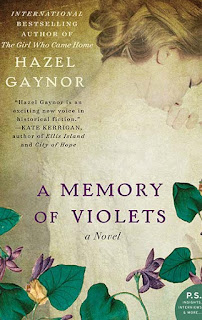Hazel Gaynor is the author of the new novel The Cottingly Secret, which focuses on a real-life case from 1917 involving two girls who convince everyone that they have photographed actual fairies. Gaynor's other books include The Girl Who Came Home and A Memory of Violets. She lives in Ireland.
Q: You note that you had considered writing
about the Cottingley fairies for a while before your agent suggested it. What
initially intrigued you about the story?
A: I grew up in Yorkshire where the fairy photographs
were taken a century ago, so I’ve always known about the Cottingley fairies. As
a novelist it is interesting to return to those long-held memories of events
and people that fascinate you, and what could be more intriguing that the
possibility of fairies at the bottom of the garden!
While I knew the photographs were eventually
disclosed as fake, I didn’t know why the girls took them, or why they took so
long to confess or how Sir Arthur Conan Doyle got involved.
It is those questions - the why, the how, and
the what if - that interest me as a novelist, and it is those questions I
explore in The Cottingley Secret, as well as the wider themes of family secrets
and the power of hope and belief.
Q: What did you see as the right blend of
fiction and history as you wrote the book?
A: While the facts of any true story offer a great
starting point for a novel, the fiction offers a tantalising space to fill in
the blanks. While I’ll always stay true to the known historical facts, I will add
fictional characters to that historical landscape.
Early in my writing I wondered who else was
affected by the events that unfolded in Cottingley and if there were fairies in
the beck, had anyone else seen them?
From there I developed the character of Ellen
Hogan, Frances’s fictional schoolteacher, who becomes the connection between
the historical facts of the fairy photographs, and the fictional world of
Olivia and her story, set in present-day Ireland.
I especially love blending historical fact with
powerful and emotional fictional stories. I kept a copy of the photograph of
Frances and the fairies on my desk while I wrote the book. I often felt she was
standing at my shoulder making sure I got it right!
Q: What surprised you most in the course of your
research for this novel?
A: The sheer scale of the interest in the girls
and the photographs surprised me, and the speed with which they became the
focus of intense media attention. Frances talks about being hounded by
reporters on her way to and from school which must have been awful for a quiet teenage
girl.
The archives at Brotherton Library at Leeds
University were also a real eye-opener. The volume of correspondence between
the girls’ parents, Sir Arthur Conan Doyle, Edward Gardner and others involved is
astonishing. It isn’t difficult to understand why the girls stuck to their
story when you see how far it travelled, and how quickly.
I was also intrigued to learn more about
Frances’s insistence that she really did see fairies in Cottingley, and that
she always maintained the fifth Cottingley photograph was genuine. The family
still hope it can be studied with modern technology to resolve the question
once and for all.
Q: Did you know how the book would end before
you started writing it, or did you make many changes along the way?
A: I’m not really a detailed planner, so I leave
a lot open as I write to see how the story and the characters progress. I knew
I wanted to leave plenty in the readers’ imagination and not be too
prescriptive about the fairies Frances saw.
I was also keen to move the story on a little in
my reimagining to leave the suggestion for other unexplored strands. I enjoy
the process of discovery as I’m writing, letting my characters emerge on the
page. Change is inevitable. It is really in the editing and re-writing that a
book is written. I enjoy that process of refinement to get to the real heart of
the story.
Q: What are you working on now?
A: I’m currently working on my next solo novel, The
Lighthouse Keeper’s Daughter, which tells the extraordinary true story of
Victorian heroine Grace Darling - famed for rescuing survivors of a shipwreck
near her home of Longstone lighthouse on the Farne Islands.
Grace Darling has interested me since learning
about her at school, and I’m thrilled to re-imagine her remarkable story
alongside the almost-forgotten history of female lighthouse keepers of the
early 20th century. The Lighthouse Keeper’s Daughter will publish in autumn
2018 in the USA and Ireland, and in spring 2019 in the UK.
Q: Anything else we should know?
A: I also have another novel releasing this
year! It's called Last Christmas in Paris and I co-wrote it with acclaimed
historical novelist Heather Webb.
It is an epistolary love story set during the
Great War between a female journalist in London, struggling to make sense of
the propaganda and her place in the war, and her childhood friend who is a
soldier at the front. It releases October 3, and we are very excited about it!
You can read more about the book here.
Get in touch with me at @HazelGaynor on Twitter,
or on Facebook. You can read more about all my books here.
--Interview with Deborah Kalb




No comments:
Post a Comment